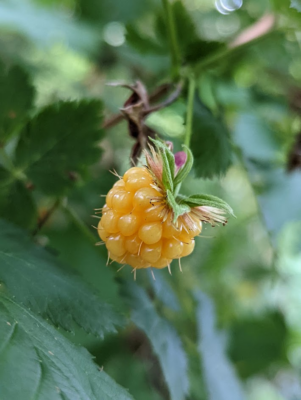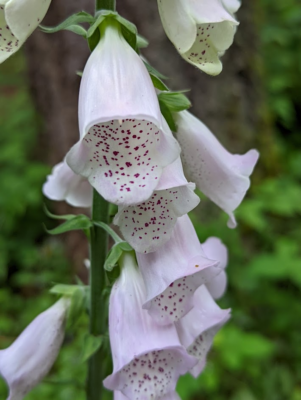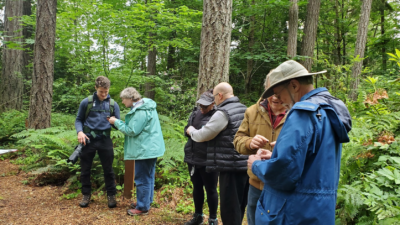On June 18, people gathered at Sehmel Homestead Park for a Walk & Talk focused on celebrating the diversity of human and more-than-human communities during Pride Month. Leading the Walk & Talk was GPC’s VISTA Education Coordinator Jaime Webb and GPC board member Dana Coggon. Dana Coggon is the current Executive Director of Pierce Conservation District and has a background in sustainable agriculture and ecological restoration. Both Dana and Jaime are passionate about education and inspiring people to be conservation stewards.
They are also both members of the LGBTQ+ community who are interested in the ways diversity intersects between conservation and the people performing conservation. Dana started off the day sharing about her own experiences as an LGBTQ+ person in the field of science. Dana compared the ways that nature is very complex and diverse to the ways human experiences are vast and different as well. One example given was the ways dichotomous keys often fail to accurately depict all of the variations within a single species, there are simply too many individual differences for many plants and animals within a population. Several of the scientists in the group chuckled at this, remembering their struggles to identify species out in the field.
Jaime and Dana then introduced the main overarching activity for the Walk & Talk: a photography prompt. As people went on a nature walk guided by Dana’s expert knowledge of plant life in the Pacific Northwest, people were challenged to try to collect all the colors of the rainbow by taking photos of nature’s many colors.

The group started walking through the native plants garden, using the park signs to learn about what species they were seeing as well as asking Dana for help identifying some that were unlabeled. From pink rhododendron flowers to brown pine cones to orange salmonberries, people took photos of nature’s many different hues.
Stopping in an open area, Jaime had the group pause to do an environmental education activity centered around making close observations called I notice, I wonder, It reminds me of. The group was instructed to pick up any loose item from the ground and discuss with a partner what they noticed about it, then what they wondered about it, and finally what it reminded them of. Some statements shared by the group included:
● I notice there are tiny red dots on the inside of this flower’s petals
● I wonder what tree this cone came from
● This flower’s texture reminds me of a cooked vegetable I love to eat
The group discussed how much people were surprised by what they were able to notice or make connections with when taking the time to slow down and stop during a walk to examine something closely.


Next, the walking group left the woods behind for a meadow area with a very small “pond” or wetland area. The group paused once again but this time instead of making observations with their eyes, the group stood in silence with eyes closed to count the number of sounds they heard. People heard anywhere from six to ten different sounds, ranging from various bird songs to people’s feet shuffling. Jaime shared how many bird species prefer to live in areas that have both woods and open areas so that they have places to nest and shelter in as well as open areas to forage for insects. It’s this diversity of habitat and resources that allows them to be successful. Birds swooped near the group, and GPC Stewardship Associate Ben Wymer identified them as swallows, explaining how their long, pointed wings helped them make the sharp and quick turns people were seeing as they caught insects on the wing.
The group approached the wetland, sounds of squelching shoes to be heard all around as people walked through the damp grass. Dana talked about the importance of conserving wetland areas such as these for water quality benefits and habitat for wildlife. People spread out around the small wetland, taking photos of the clear water and various white, yellow, and even tiny blue flowers. Others focused on the frogs and water skimmers and watched them scatter away from the humans.
Jaime then handed out materials for a poetry activity. People were prompted to think about the ways they personally connect to nature, using their memories and/or the day’s experiences to inspire their free style writing. To connect with the idea of conservation for all, the poem structure was an acrostic poem, meaning the first letter of each line had to start with the letter of a word, in this case LGBTQIAP. People took their paper and pencils and spread around the lovely little wetland to write their poems. Some sapsuckers, again identified by Ben Wymer, decided to drop by the snag in the wetland as further inspiration for the poets. People shared their poems as a large group at the end of the activity, showing both diverse thoughts and writing structures, and also the similarities of people’s experiences and appreciation for nature.
The Walk & Talk then moved to enter the forest once again on a different trail. This time, people found lichens and mushrooms of different colors rather than flowers for their photography subjects.
To conclude the nature walk, Jaime handed out brochures as further resources for current leaders whose work connects the human and more-than-human diversity efforts. Their books, blogs, or organizations can be used to further explore the theme of conservation for all and how people already make connections between conservation work and human diversity.
These leaders can be found below:
● Aletta Brady: nonbinary activist who founded Our Climate Voices which highlights the stories of people most impacted by climate change: women, LGBTQ+ people, BIPOC, and disabled people
● Pinar Sinopoulos-Lloyd: co-founder of Queer Nature, an education and ancestral skills program and blog
● Patti Gonia: a drag queen who uses their performing arts to bring attention to climate change
● Joan Roughgarden: a trans professor who wrote Evolution’s Rainbow, a book that discusses the diversity within nature and humanity
● Lindi von Mutius: a bisexual woman who runs the platform Out4Sustainability
